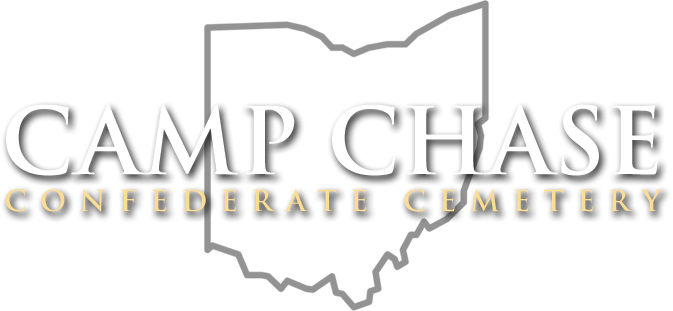The Captain and His Sergeant
“Grave #2064 at the Camp Chase Cemetery is a double inscription and the majority of double inscriptions on tombstones at the cemetery are located today in row 41. It currently states “CAPT. BROWN ALA. REG. C.S.A.”
With only a common surname and a state and rank to go by it made the chore of finding him among the thousands of soldiers difficult. Just at the Camp Chase Cemetery alone he was one of seventeen soldiers with the surname of Brown who now have Confederate tombstones.
It soon became apparent that his current tombstone was incorrect. Captain Brown had nothing to do with the State of Alabama and the error may have been caused by a Union clerk. His actual name and unit was Captain William L. Brown of Company B of the 41st Tennessee Infantry and he was from Bedford County, Tennessee and he would be the second William L. Brown who died at the Camp Chase Cemetery and should not be confused with Private William L. Brown from Louisiana affiliated with tombstone #1311.
Captain William L. Brown had formed his own company and was appointed as Captain on November 4, 1861 at Camp Trousdale, Tennessee known as Captain Brown’s Company Tennessee Volunteers which subsequently became Company B of the 41st Tennessee Infantry. The nickname of Company B was the Richmond Gentry’s. Wikipedia defines a gentry in part as “people of good social position” Richmond, Tennessee was a town located in Bedford County, Tennessee. For the sake of a general location of Bedford County today its county seat is located in Shelbyville, Tennessee.
Also enlisting in Captain Brown’s company was an eighteen year old named Sumner Archibald Cunningham from Bedford County, Tennessee and he would go on to be quite famous after the war concerning the United Confederate Veterans and the Sons of Confederate Veterans created in 1896.
The 41st Tennessee Infantry surrendered at Fort Donelson, Tennessee along with the majority of the garrison on February 16, 1862. The majority of field officers taken at Fort Donelson with the rank of major and higher would find their final destination as Fort Warren, Massachusetts while the majority of junior grade officer’s lieutenants and captains would find their final destination as Camp Chase, Ohio. The majority of enlisted prisoners would be spread to several northern POW camps including Camp Douglas, Illinois and Camp Morton, Indiana. However a select few of the enlisted personal from Fort Donelson would find themselves also at Camp Chase. During the third week of April, 1862 the majority of junior officers at Camp Chase would be transferred to Johnson’s Island located at Lake Erie in northern Ohio.
The majority of prisoners taken at Fort Donelson would be paroled and exchanged per the Dix-Hill Cartel agreement in the fall of 1862. The majority of Federal POW Records reported the death of Captain William L. Brown of Company B of the 41st Tennessee Infantry on March 8, 1862 due to sickness and died at the Post hospital at Chase. Records are unavailable at this particular time frame in January, February and March of 1862. Regarding the burial site of Captain William L. Brown, the compiler feels he was either buried near the Post Hospital or at the East Cemetery in Columbus, Ohio but the first recorded burial at the East Cemetery was not done until April 6, 1862 and that the Camp Chase Cemetery did not come into being until August 1, 1863.
The Camp Chase Cemetery itself is a combination of three separate cemeteries. Those who died after August 1, 1863 were buried in the Chase Cemetery itself and those who had been buried at the East Cemetery prior to the establishment of the Chase Cemetery were reinterred to the Chase Cemetery in May of 1869 by Captain Irving of the United States Quartermasters Department and he reported only fifty reinterred to the Chase Cemetery and lastly the majority of those Confederates who died at Camp Dennison, Ohio mostly due to wounds at the Battle of Shiloh were also reinterred to the Chase Cemetery in 1869 and there were thirty-one in number. Those who had died in 1861 at Camp Chase were mentioned to have been buried at the North Graveyard in Columbus, Ohio but nothing is mentioned as their bodies being reinterred to the Chase Cemetery. Indeed Captain Irving reported to his superior General Bingham that he found no Confederate bodies at the North Cemetery. However the railroad had laid new tracks through some of the North Graveyard prior to Captain Irving’s search and the railroad had apparently little sympathy for any of the deceased in their quest for new tracks regardless of their color of uniform or civilian status.
Sergeant Sumner Archibald Cunningham was taken to Camp Morton, Indiana after his capture at Fort Donelson and later paroled and exchanged in latter 1862. He would return to duty with Company B of the 41st Tennessee Infantry and fought in some bloody battles such as the Battles of Franklin and Nashville. On a page on his Compiled Military Service Records it stated 1st Sergeant Sumner A. Cunningham was in command of his Company B toward the end of the war. He would surrender in May of 1865.
Well after the war while trying various newspaper and magazine jobs he started the Confederate Veteran Magazine in 1893 in which many historians today often refer to. Many of us today just remember him as S. A. Cunningham.”

